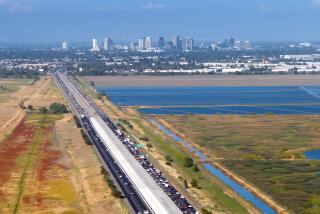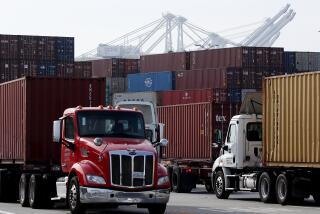‘Sharing Road With Truckers’
- Share via
John Kendall’s article (March 31) on trucker conduct on state highways is too gentle a treatment of an aggravating situation that results in injury, property damage and loss. The sidebar on “Sharing the Road with Truckers” seems aimed at having the automobile public adapt to the characteristics of trucks and their drivers.
The apparent underlying reason for many, if not most, accidents involving trucks is the speed at which these vehicles travel. It is pointed out, for example, that the stopping distance for a tractor-trailer unit may be 400 feet at 60 miles per hour. Compare this with that for a passenger vehicle, which is 200 feet or less. Therefore, to really “share the road,” the tractor trailer should be moving at a speed enabling stopping in a distance comparable to that of a passenger vehicle. This is the predominant vehicle on the road anyway, outnumbering trucks in virtually any highway or city street and therefore most likely to set the prevailing speed of vehicular movement.
The California Highway Patrol maintains high visibility on state highways. However, one seldom sees them aggressively pursuing and pulling over trucks that are traveling about 60 m.p.h., whether on congested Southern California freeways or on the likes of Interstate 5 in Central California. If citations and fines are expected to deter passenger vehicle operators from excessive speed and endangerment of others, it seems logical that the CHP should apply the same rules to truckers.
CHP Commissioner James E. Smith’s allusion to the “law-abiding majority” ignores the fact that this law-abiding majority almost universally ignores the 55-m.p.h. speed limit.
The principle of “driving safely for conditions” in the Motor Vehicle Code can apply to excessive speed of trucks in the heavy traffic of many freeways, whether the speeds are 55, 60 or 70 m.p.h. A truck moving at 65 on I-5 in the San Joaquin Valley poses a much greater threat to safety if it moves at the same speed in the congested but generally fast-moving Santa Ana or San Diego freeways.
It is a rationalization to attribute accidents to causes related to deregulation, competition, untrained and maverick drivers, improperly operated passenger vehicles, poor truck maintenance, tired drivers, etc., as though such causes are separable from excessive speed. Reducing allowable speed and aggressive police action against and citation for violation will contribute significantly to lower truck-related accident frequency.
JACK W. PRATT
Pasadena
More to Read
Sign up for Essential California
The most important California stories and recommendations in your inbox every morning.
You may occasionally receive promotional content from the Los Angeles Times.










